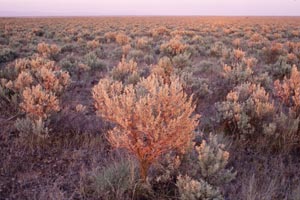Sagebrush Territory
Air Date: Week of June 14, 2002
Commentator Guy Hand grew up in the vast, arid sage land of Idaho. It wasn’t until he moved away from sagebrush country that he realized how much he missed it.
Transcript
CURWOOD: The West’s vast sage lands have long been overlooked and abused, even by those born onto it. But producer Guy Hand shares with us his feelings about how the land has come to grow on him.
HAND: To tell you the truth, I hated growing up in sagebrush country. Southern Idaho, through my adolescent eyes looked all gray, green, and hopeless. I saw no future on that sagebrush sea, no way to build a life that didn’t include work boots and low wages. Hard winter winds and hot summer fires. My friends agreed. We saw sage land as good for nothing but relieving the frustrations of living in it, with guns, dirt bikes, and cheap beer. Or as a convenient place to dump junk like old couches, broken stoves, and dead dogs. We saw sage land as wasteland and we weren’t alone.
Those hapless pioneers who stumbled through the high desert on the Oregon Trail weren’t exactly charmed by what they saw either. One called it "hideous world marked by the graves and the bones of dead men." By the twentieth century America’s attitude towards sagebrush hadn’t much improved. We burned it, we bombed it, we buried our nuclear waste in it. And even though we’ve since learned to love certain kinds of desert, like the photogenic red rock of southern Utah, as a nation we don’t exactly ache for a Sagebrush National Park.

(Photo: Guy Hand)
But that doesn’t mean all this rasping aridity is lost on everyone. My dad, for one, loved it. When I was a kid, he’d pull me to the top of some jagged lava outcrop and peer down on dust and sun-drilled sage with a look of pure pride. He’d shield his eyes with a calloused hand like a salute and see something I couldn’t. Maybe it was the soaring emptiness, the bottomless quiet. Maybe it was the way the sky met the ground so far away, it looked like the world was made of nothing but sage. I’m not sure. Dad wasn’t much for talking about the things he loved. He thought I’d see it.
Only after I escaped sagebrush, only after decades living in places like New York and L.A. did I actually begin to miss it. I’d be walking along Fifth Avenue feeling utterly urbane when suddenly I’d catch a whiff of sage and go weak in the knees. I’d be cruising along the 101 Freeway just north of Hollywood and find myself tangled in the memory of a childhood thunderstorm, one that bloomed over the Snake River like a huge white rose. I could taste the rain.
As time passed, a kind of desert dementia set in. I couldn’t shake it. It pulled at me like gravity. It pulled at me until I lost the strength to resist it. Finally I gave in, deserted my big life and moved back here to Idaho, to sagebrush. Maybe you really never can take the country out of the boy. Or maybe this boy in his rush to be somewhere else forgot to look closely at where he was. I can’t explain it any better than my dad could. But here I am, surrounded by sage and happy.
CURWOOOD: Guy Hand writes and produces radio amidst the sagebrush near Boise, Idaho.
[MUSIC: DAVID ROSS MACDONALD. "WAITING FOR CLAIRE," SOUTHERN CROSSING, DRM 2002]
Living on Earth wants to hear from you!
Living on Earth
62 Calef Highway, Suite 212
Lee, NH 03861
Telephone: 617-287-4121
E-mail: comments@loe.org
Newsletter [Click here]
Donate to Living on Earth!
Living on Earth is an independent media program and relies entirely on contributions from listeners and institutions supporting public service. Please donate now to preserve an independent environmental voice.
NewsletterLiving on Earth offers a weekly delivery of the show's rundown to your mailbox. Sign up for our newsletter today!
 Sailors For The Sea: Be the change you want to sea.
Sailors For The Sea: Be the change you want to sea.
 The Grantham Foundation for the Protection of the Environment: Committed to protecting and improving the health of the global environment.
The Grantham Foundation for the Protection of the Environment: Committed to protecting and improving the health of the global environment.
 Contribute to Living on Earth and receive, as our gift to you, an archival print of one of Mark Seth Lender's extraordinary wildlife photographs. Follow the link to see Mark's current collection of photographs.
Contribute to Living on Earth and receive, as our gift to you, an archival print of one of Mark Seth Lender's extraordinary wildlife photographs. Follow the link to see Mark's current collection of photographs.
 Buy a signed copy of Mark Seth Lender's book Smeagull the Seagull & support Living on Earth
Buy a signed copy of Mark Seth Lender's book Smeagull the Seagull & support Living on Earth

